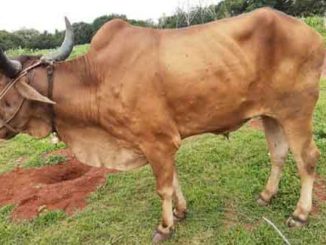Downer cow is any cow which was down in sternal recumbency for more than 24 hours. The downers cow syndrom can be defined as a condition occurring following parturient paresis characterized clinically by prolonged recumbency even after 2 successive infusions with calcium. The condition may occur both in cattle as well as buffaloes and is restricted to heavy producers (e.g. exotic and crossbred Jersey and Holstein Friesian cows). Holstein breed is highly susceptible to this disease.The disease occurs most commonly after calving in high yielding dairy animals. This may occur in late lactation too. High incidence is noted in winter but the disease may occur through out the year. Milk fever may turn to downer and about 30 per cent of cows treated for milk fever will not stand for up to 24 hours after treatment and turn to downers animals.
Factors Incriminated as Possible Cause of Downers
- Milk fever
- Persistent hypocalcaemia
- Persistant Hypophosphatemia
- Hypokalemia
- Hepatosis (Fatty liver)/Fat cow syndrome
- Myocardosis
- Septic mastitis
- Muscular injuries, rupture of round ligament, Hip dislocation etc.
- Excessive Protein intake
- Toxic mastitis and Metritis
- Vitamin E and selenium deficiency
- Miscellaneous causes e.g. management errors.
Symptoms
The disease may be of two types, viz.,
- Alert Downers.
- Non-alert Downers.
Alert Downers
The cow remains alert, bright and maintains proper appetite. Temperature, pulse, respiration, urination and defecation are normal. The affected animals usually crawl around on the forelimbs while the hind limbs remain in a flexed position owing to potassium depletion. Peculiar dog sitting posture may also be seen. This type of stance is ascribed as ‘Creeper Cow’. If the cow remains in this condition for more than seven days, the prognosis is grave. The cow generally dies due to septicaemia or myocarditis. Buffaloes are more responsive to external stimuli and assistance in the attempts of rising.
Non-alert Downers
Animals are dull, depressed and unable to attain sternal recumbency despite assistance and remain in lateral recumbency. Complete loss of appetite, elevated cardiac and respiratory rates, decubital ulcers at pressure points, tachycardia and arrhythmia are evident. Development of myocardial lesions hastens death of the animal despite treatment.
Prognosis
Prognosis is favourable if the disease is due to metabolic disorders.
Treatment
First rull out possible fractures, dislocation, sprain by careful examinations. Metritis mastitis spinal injury, malposition and fixing of foetus in advance gestation by rectal examination. Attempt should be made to lift the cow. Adequate bedding should be provided.Physiotherapy comprised of soft bedding, frequent rolling, sand or paddy straw bedding needs to be provided. Animal needs to be rolled from one side to another side for every 4 hours interval to prevent bed sores. Animals need to be assisted to stand for at least 30 minutes four times a day using supportive sillings. Massage of hind limbs with liniment camphor, hot water fomentation, Mag Sulph or Epsom salt formentation may be done. There is no specific treatment for the disease.
Calcium magnesium borogluconate preparation, Vitamin-E and Selenium preparation, use of potassium, Vitamin D, Corticosteroids, Vitamin B1 (Thiamine) recommended.
For the cases suspected for hypocalcaemia and hypomagnesaemia and hypophosphataemia.
- Parenteral administration of Inj. Mifex, Inj. Calmax, Inj. Calcimal, Inj. Miphocal, Inj. Lactomag @ 1 ml/kg body weight to be slowly infused.
- Injection Sodium acid phosphate, organic or inorganic phosphorus , Inj. Sodaphos (Vetnex), Inj. T. Phos (Sarabhai), Inj. Beetphos (Bee Te Pharma), Inj. Torpophosphan (Intervet), Inj. Uremin (Glaxo), Inj. Alphos-40 (Alved) @ 10-15 ml by IM, IV or SC as per convenience and need to be administered to reduce myotonia.
- Good quality potent neurotropic B-vitamins viz. Inj. Polyvet (Excell), Inj. Tribivet (Intas), Inj. Neurovet (Alved), Inj. Neuroxin-12 (Sarabhai Zydus) @ 5-10 ml daily or on alternate day by IM route for 3-5 days can be advocated.
- Potassium acetate 10 per cent solution 100 ml IV daily for 10 days or Potassium Chloride @ 30 g orally can be prescribed.
- Good quality Mineral Mixtures g. Minfa (Intas), Ranmix Total (Vetnex), Agrimit Fort (Glaxo SmithKline) 25-30 g OD may be given for 10-15 days. Vitamin-E and selenium preparation viz., Inj. E-Care Se @ 10 ml IM on alternate day for 3 days can be recommended.
- If Downers due to pelvic muscles and nerve injuries (owing to forced traction),treatment should be Epidural injection of Neurobion, Gentamycin and Dexamethasone @ 2 ml each daily for 7 days. Potassium chloride 30 g orally for 7 days, Inj. Tribivet, Inj. Polyvet, Inj. Nuroxin-12 @ 5-10 ml by IM route on alternate day for 7 days can also be given.
- If Downers due to Post Parturient Septic Metritis Oxytetracycline – 10 mg/kg IV with NS or DNS Povidone iodine 20-40 ml IU. C-Flox TZ (Intas), Enrocin IU (Vetnex) Ladexin IU (Legend), Lixen IU (Glaxo SmithKline) for intrauterine infusion. Inj. Dexamethasone 1 mg/kg body weight Inj. Meloxicam (viz. Inj. Zobid-40, Inj. Melonex, Inj. A3 vet, Inj. Meloxy) 10-15 ml IM daily for 3 days or Inj. Ketoprofen/Neoprofen (Vetnex)/Ketop (Alembic) @ 1 ml/33 kg body weight can be administered.
- If Downers Due to Fall on Trenches and Slippery Floor Without Fracture/ Dislocation Epidural injection with Neurobion, Gentamycin 2 ml daily for 5 days. Inj. Dexamethasone sodium 1ml diluted in equal amount of distilled water by epidural route can also be adviced. Inj. Meloxicam g. Inj. A3 Vet, Inj. Zobid-M, Inj. Zobid-20, Inj. Meloxicam) @ 15-30 ml by IM route or Inj. Ketoprofen (e.g. Neoprofen or Ketop) @ 1 ml/33 kg body weight by IM route for 3 days. Potassium chloride orally @ 30 g daily may be tried.
- If Downers Due to Pelvic Muscles and Nerve Injuries Due to Fixed Traction Epidural injection of Neurobion, Gentamycin and Dexamethasone 2 ml each daily for 7 days. Inj. Tribivet/Polyvet/Neurovet @ 5-10 ml IM on alternate day IM for 7 days. Pot chloride of orally for 7 days.
| The content of the articles are accurate and true to the best of the author’s knowledge. It is not meant to substitute for diagnosis, prognosis, treatment, prescription, or formal and individualized advice from a veterinary medical professional. Animals exhibiting signs and symptoms of distress should be seen by a veterinarian immediately. |






Be the first to comment